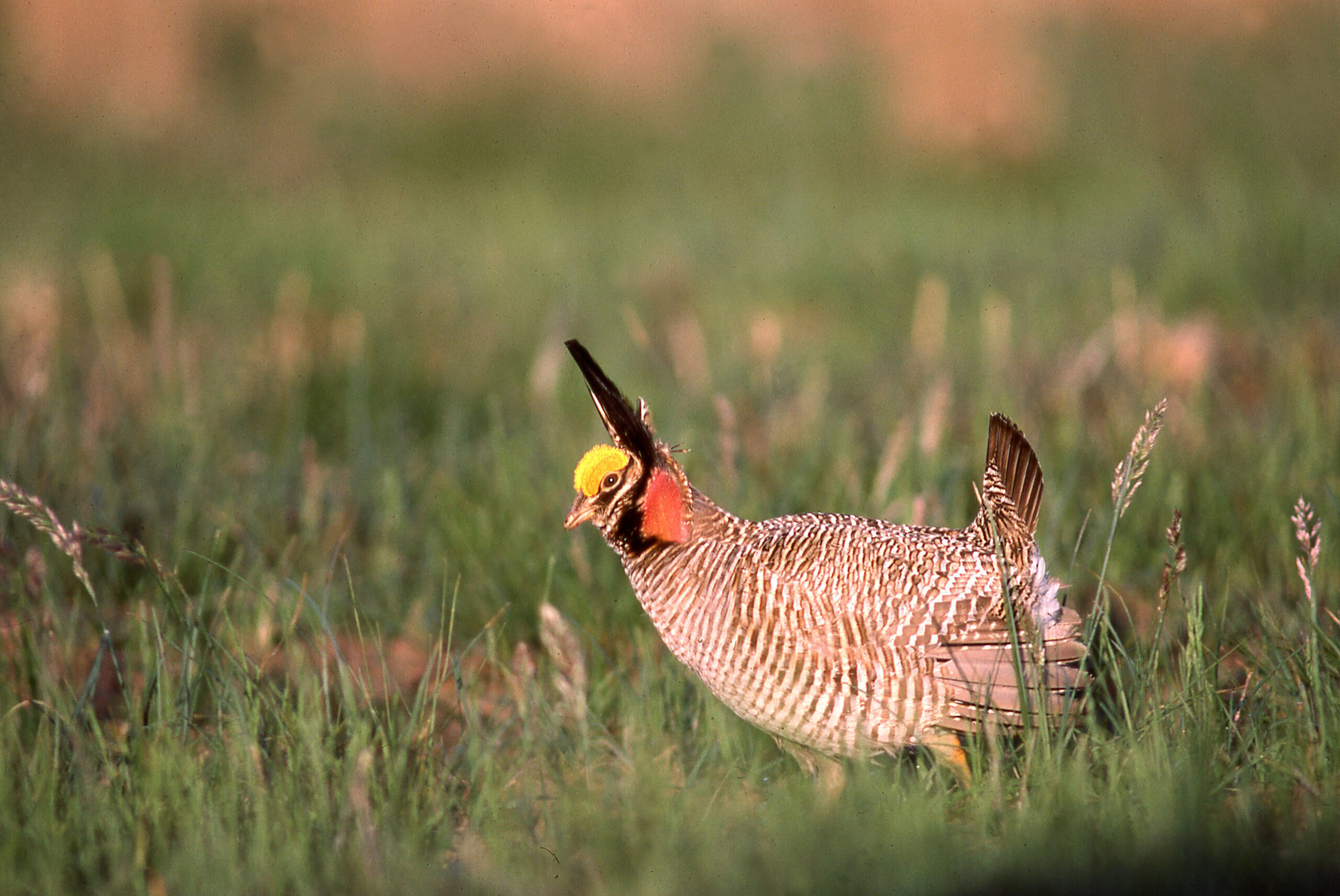
A male lesser prairie chicken displaying on a breeding ground in southern Kansas. Photo by Chris Madson, copyright 2014, all rights reserved.
WELL, THE DECISION COMES AS NO SURPRISE.
On March 29, David Counts, a Trump-appointed judge in the U.S. District Court for the Western District of Texas, split a legal hair to block any action to protect the lesser prairie chicken, a bird the U.S. Fish and Wildlife Service listed as” threatened” in part of its range and “endangered” in the rest back in 2022. In his decision, Counts conceded that the Fish and Wildlife Service was not required to weigh the economic impacts of its decision as part of its intention to list a rare species and threatened or endangered. BUT, before the Service makes rules to protect that species, he ruled, it is legally bound to consider the economic impact of those rules.[i]
Get it? The Fish and Wildlife Service has the authority to list the lesser prairie chicken, regardless of the economic impact that decision may have, but it can’t make any rules to protect lesser prairie chickens without considering the economic impact those rules might have.
The contortions Judge Counts goes through to justify this explication of the Endangered Species Act cover ten double-spaced pages, and at the end of that careful argument, a careful reader is left wondering how we can expect the Fish and Wildlife Service to “provide for the conservation of the . . . lesser prairie chicken” as the Endangered Species Act requires while, at the same time, avoiding any regulation that might inflict the least economic inconvenience on anyone doing any sort of business on the southern Great Plains.
Practically all the former and currently occupied range of the lesser prairie chicken is privately held, and, practically speaking, the Fish and Wildlife Service can’t and won’t prosecute a landholder for overgrazing native prairie, building fences, plowing a quarter section of grassland to install a center-pivot irrigation system, or doing much of anything else that threatens the species.
About the only activities the Service might impede would be large-scale development by big corporations— the installation of major utility lines or the opening of new oil and gas fields. Even in those cases, the interests of the lesser chicken and the developers would be balanced in court before any limit would be placed on a developer’s plans.
The Fish and Wildlife Service, state wildlife agencies, and the vast majority of conservationists with an interest in lesser chickens are fully aware of the challenges that arise when the last remnants of a wild species survive only on private land. That’s why efforts to recover populations of lesser chickens focus almost entirely on incentives that compensate farmers and ranchers for managing their grasslands to encourage these native grouse.
It’s interesting that the judge himself conceded that the lawyers who sued the Fish and Wildlife Service hadn’t produced evidence that their clients were actually harmed by the rules protecting lesser chickens— they “brought too little in the way of national impact,” according to Judge Counts. That should come as no surprise since the on-the-ground impact of the listing has had little, if any, impact on landholders. Nor is this lack of effect unusual on the modern landscape.
Over the decades, the Fish and Wildlife Service has been made painfully aware of the fact that, in most cases, successful protection and recovery of threatened and endangered species depends on public support, at the national level and also down where the management of those species touches the lives of the people who live with them. The Service has made arrangements to suspend the rules of the Endangered Species Act in places where rare species like the black-footed ferret are introduced, recognizing that the way the landholder is managing his land already favors the ferret, that the best way to help the species is to cooperate with that landholder. The Service compensates ranchers for the loss of livestock to wolves and grizzlies because the impact of those losses should rightly be shared by the public at large. And, in the case of the lesser prairie chicken, efforts are being made to use funding from the Farm Bill to help landholders help the birds.
In short, the Fish and Wildlife Service routinely considers the potential cost of managing threatened and endangered species, especially where traditional practices by farmers and ranchers are concerned.
The application of the Endangered Species Act has evolved over the decades since its adoption in 1973, partly because of shifting legal precedent and, in large part, because the real-world challenges of protecting and re-establishing habitat for rare wildlife have become obvious to conservationists and the public at large. The benefits and costs of protecting endangered species are already being weighed, and the efforts on behalf of those species have long been tempered by that process.
Judge Counts would like to bring that process into his courtroom. I must say I doubt his motives, and I challenge his ability to find fairer compromises than the ones already being made.
The long-standing debate between people who care about our wild heritage and people who are focused solely on the bottom line reminds me of an observation the British wit Oscar Wilde made many years ago. “A cynic is a man who knows the price of everything,” he quipped, “ . . . and the value of nothing.” It’s easy to build a balance sheet with columns for profit and loss, far more difficult to determine the value of a lesser prairie chicken and the prairie it calls home.
———
[i] Counts, David, 2025. Kansas Natural Resource Coalition, et al. v United States Fish and Wildlife Service. MO:230CV-00159-DC.
https://www.endangeredspecieslawandpolicy.com/assets/htmldocuments/NewBlogs/EndangeredSpecies/lesser-prairie-chicken-court-ruling.pdf. Accessed April 7, 2025.
Leave a Reply
You must be logged in to post a comment.